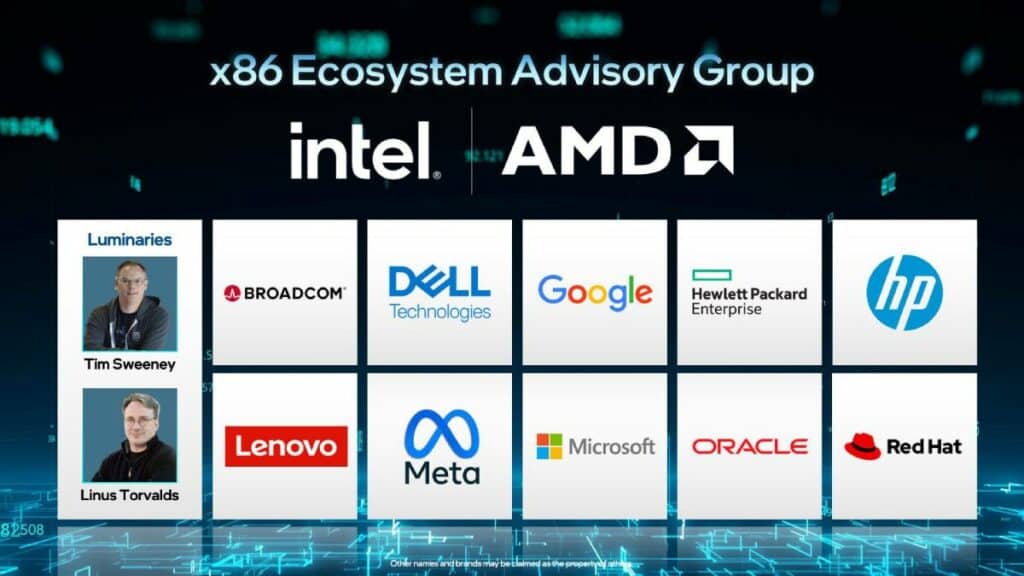Intel & AMD collaborate on new x86 Ecosystem Advisory Group for all the right reasons

Table of Contents
With ARM-based chips extending to PCs and servers, it seems Intel and AMD are concerned about their good old x86 architecture. Don't get us wrong, the x86 has been here for over forty years, and it has served us exceptionally for all this time. There are only two companies that have the license to manufacture x86-based chips: The founder of x86 itself, Intel, and its rival, AMD.
While the two companies share the same architecture, the way they implement different features can vary a lot, leading to a number of problems for developers. As you can guess, ARM and RISC-V architectures don't have this problem. Both architectures use a much simpler core design, aimed at increased power-efficiency and better flexibility. Plus, the recent news that 40% of Notebooks may be powered by ARM in 2029 predicts where the future lies.
Prime Day is finally here! Find all the biggest tech and PC deals below.
- Sapphire 11348-03-20G Pulse AMD Radeon™ RX 9070 XT Was $779 Now $739
- AMD Ryzen 7 7800X3D 8-Core, 16-Thread Desktop Processor Was $449 Now $341
- ASUS RTX™ 5060 OC Edition Graphics Card Was $379 Now $339
- LG 77-Inch Class OLED evo AI 4K C5 Series Smart TV Was $3,696 Now $2,796
- Intel® Core™ i7-14700K New Gaming Desktop Was $320.99 Now $274
- Lexar 2TB NM1090 w/HeatSink SSD PCIe Gen5x4 NVMe M.2 Was $281.97 Now $214.98
- Apple Watch Series 10 GPS + Cellular 42mm case Smartwatch Was $499.99 Now $379.99
- ASUS ROG Strix G16 (2025) 16" FHD, RTX 5060 gaming laptop Was $1,499.99 Now $1,274.99
- Apple iPad mini (A17 Pro): Apple Intelligence Was $499.99 Now $379.99
*Prices and savings subject to change. Click through to get the current prices.
To answer this, enter the new x86 Ecosystem Advisory Group – a much-needed initiative by the two rivals, so they are on the page with their x86 architecture. The big names in this venture include Broadcom, Dell, Google, Hewlett Packard Enterprise, HP Inc., Lenovo, Meta, Microsoft, Oracle, and Red Hat, with luminaries Linus Torvalds, the man behind Linux, and Tim Sweeney, CEO of Epic Games.
What the Ecosystem Advisory Group aims to achieve
Put simply, the x86 Ecosystem Advisory Group aims to make the iconic x86 architecture more like its new competitors – flexible, scalable, and future-proof, and it does so by boosting cross-communication between the two rivals and other group members.
The three key objectives of this advisory group are:
- For us: Whether we're using Intel or AMD, all software should work more smoothly without any compatibility hiccups.
- For developers: Any new feature or program should be implemented more consistently, regardless of the platform.
- For the future: Like with developers, any upcoming feature or product, developed by Intel or AMD, should fit into all x86-based processors seamlessly.
This isn't the first time we've seen Intel and AMD join forces on a subject. The two have also worked together to bring key technologies like USB and PCIe to life. x86 needs some attention in light of competition (especially for laptops), and these two big players are giving it just that.

The industry has been vocal
With all the big names like Dell, Google, Microsoft, and Meta joining the ecosystem advisory group, their CEOs showed quite excitement towards the initiative. Announcing the group, Intel's CEO, Pat Gelsinger, said “We proudly stand together with AMD and the founding members of this advisory group, as we ignite the future of compute, and we deeply appreciate the support of so many industry leaders”
AMD's CEO, Lisa Su, also emphasized how the advisory group is going to future-proof the x86 architecture, saying “We are excited to bring the industry together to provide direction on future architectural enhancements and extend the incredible success of x86 for decades to come.”
Here's what Dell's Chairman and CEO, Michael Dell, said about the initiative “Dell has a long history of working with the x86 platform. We look forward to collaborating with Intel, AMD and fellow x86 Advisory Group members to continue driving innovation for our customers and partners.”
Similarly, Microsoft's Chairman and CEO, Satya Nadella also showed great enthusiasm towards the group, saying “By bringing together partners across the industry, the x86 Ecosystem Advisory Board will play a critical role in shaping future x86 architectural features and help drive software consistency and standard interfaces.”
Is this enough?
There is no denying that the advisory group is definitely a step in the right direction, but Intel and AMD still have a long way to go if they plan to level the playing field with ARM and RISC-V in terms of compatibility.
Last year, we saw Intel propose the x86S architecture – a 64-bit-only version of x86, aimed at simplifying the 64-bit implementation by removing support for 16- and 32-bit.
By the looks of it, I think this group will help turn x86S into a reality now more than ever, and with AMD on board, we should have little to no compatibility issues between the two rivals.
Fierce competition among big companies always leads to the benefit of the consumers, and the same applies here. How much this group changes the future ISAs and to what extent, is something we will see with time, but the fact that this group exists shows that Intel and AMD are looking to fix things, all because of competing architectures like ARM and RISC-V.

